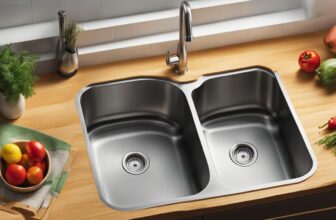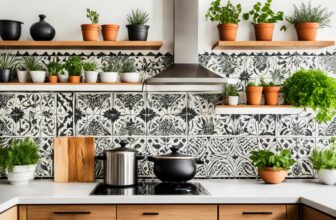Kitchen Install Time: Fitting Duration Explained
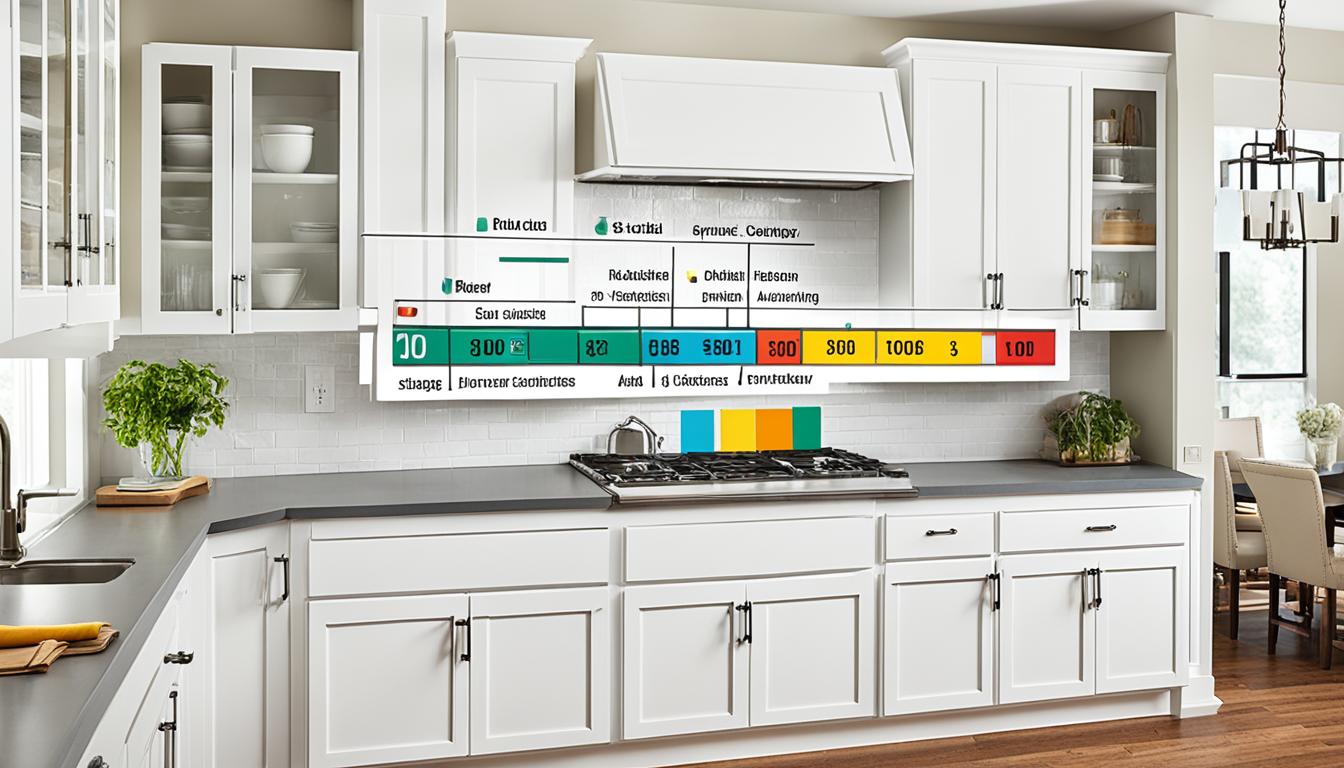
Welcome to our comprehensive guide on kitchen installation! If you’re planning to renovate your kitchen, it’s essential to have a clear understanding of the time it takes to fit a kitchen. In this section, we will explore the average duration and provide you with insights into the timeline involved in a kitchen installation. Let’s dive in!
Key Takeaways:
- The duration of fitting a kitchen can vary based on various factors, such as the size and complexity of the project.
- The planning and design phase plays a crucial role in determining the overall timeline of your kitchen installation.
- The timely procurement and delivery of materials are essential for avoiding delays during the installation process.
- Proper preparation of the space before installation is necessary to ensure a smooth and efficient process.
- Demolition and removal of the existing kitchen are often required before the new installation can take place.
Now that we’ve provided a brief introduction, let’s dive deeper into the factors that can affect the time it takes to fit a kitchen. Stay tuned for the next section, where we discuss the various factors impacting kitchen fitting time.
Factors Affecting Kitchen Fitting Time
Before we delve into the average duration of fitting a kitchen, it’s important to understand the various factors that can influence the time it takes to complete the installation. These factors can greatly impact the overall timeline of your kitchen project and should be considered during the planning phase. Let’s explore some of the key factors that can affect the kitchen fitting time:
- Kitchen Size and Complexity: The size and complexity of your kitchen design play a significant role in determining the installation duration. Larger kitchens with intricate layouts or custom features may require more time for fitting and installation.
- Scope of Work: The scope of work involved in your kitchen renovation can also affect the fitting time. If extensive electrical, plumbing, or structural changes are necessary, it may increase the overall duration.
- Material Selection: The selection and availability of materials can impact the fitting time. If you opt for custom or specialized materials that require longer lead times, it may extend the duration of your kitchen installation.
- Contractor Availability: The availability of skilled contractors can influence the installation timeframe. Scheduling conflicts and high demand for experienced professionals in your area can potentially delay the completion of your kitchen fitting project.
- Unforeseen Issues: Unexpected issues, such as hidden structural problems or discovered electrical or plumbing issues, can arise during the installation process. Dealing with these unforeseen challenges can add time to the overall project.
By considering these factors, you can better estimate the duration required to fit your kitchen and plan accordingly. It is important to communicate effectively with your kitchen fitter and project manager to ensure a realistic timeline that aligns with your expectations.
“The size and complexity of your kitchen design play a significant role in determining the installation duration.”
Now that we have discussed the factors that can affect kitchen fitting time, let’s move on to the planning and design phase in the next section.
Planning and Design Phase
The planning and design phase is an essential part of any kitchen remodeling project. This phase sets the foundation for the entire process and greatly influences the overall duration of your kitchen fitting. By carefully planning and managing your renovation schedule, you can ensure a smooth and efficient kitchen installation.
Importance of Planning
Proper planning plays a vital role in determining the timeframe of your kitchen remodel. It involves creating a detailed layout, considering the required materials, and finalizing the design elements. The more time you invest in planning, the better prepared you will be for the subsequent stages of the project.
“Good planning is essential for the success of any kitchen remodel. It helps in choosing the right materials, coordinating with contractors, and avoiding potential delays.”
Working with Design Professionals
If you’re not experienced in kitchen design, it’s recommended to work with design professionals who can guide you through the process. They will help translate your ideas into a functional and aesthetically pleasing kitchen design. Collaborating with design experts can save time and prevent costly errors during the installation phase.
Choosing Materials and Finishes
During the planning stage, you’ll need to decide on the materials and finishes for your new kitchen. Consider factors such as durability, maintenance requirements, and aesthetics. It’s important to choose materials that align with your vision, fit your budget, and can be acquired within a reasonable timeframe.
Managing Your Renovation Schedule
One of the key elements in controlling the duration of your kitchen fitting is effectively managing your renovation schedule. Create a detailed timeline that considers the availability of contractors, deliveries of materials, and any required permits. Regular communication with your team and suppliers will help ensure that the project stays on track.
To help you manage your renovation schedule effectively, here are some tips:
- Set realistic deadlines for each phase of the project.
- Communicate with contractors and suppliers to confirm availability and delivery dates.
- Stay flexible and be prepared for unforeseen delays.
- Prioritize tasks and allocate resources accordingly.
By following these guidelines, you can optimize the planning and design phase, leading to a smoother and more efficient kitchen remodeling project.
Ordering and Delivery of Materials
Efficiently managing the ordering and delivery of materials is a crucial aspect of ensuring a smooth and timely kitchen fitting process. The timely procurement of materials can have a significant impact on the overall duration of your kitchen installation. Let’s explore why this step is so important and how it can affect your kitchen fitting time.
The Importance of Timely Material Procurement
When it comes to fitting a kitchen, timely material procurement is essential to avoid unnecessary delays. Waiting for materials to arrive can significantly extend the overall duration of your kitchen installation. By ordering materials in advance and coordinating delivery with your installation schedule, you can minimize downtime and keep your project on track.
It’s recommended to work closely with your kitchen designer or contractor to determine the required materials for your project. They can provide guidance on the lead time for each item, allowing you to plan the ordering and delivery accordingly. By staying informed about the availability of materials, you can make informed decisions and avoid any last-minute surprises that could cause delays in your project’s timeline.
Coordinating Delivery Dates
Once you have ordered the necessary materials, it’s crucial to coordinate delivery dates to ensure a smooth workflow during the installation process. Schedule the delivery of materials based on the availability of your installation team and any other tradespeople involved. By aligning these schedules, you can minimize idle time and maximize efficiency.
Keep in mind that some materials may require additional time for inspection and preparation before installation. For example, custom-made cabinets might need extra processing time, so make sure to account for these factors when coordinating the delivery schedule. Good communication and coordination between your suppliers, installer, and other contractors are key to ensuring a seamless delivery process.
Minimizing Delays and Maximizing Efficiency
By effectively managing the ordering and delivery of materials, you can minimize delays and maximize efficiency throughout the kitchen fitting process. Here are some tips to help you achieve this:
- Plan ahead: Start the ordering process early to allow for any potential delays in material availability or delivery.
- Communicate: Maintain open lines of communication with your suppliers, installer, and other contractors involved in your project to ensure everyone is on the same page.
- Track progress: Stay informed about the status of your material orders to anticipate any issues and make necessary adjustments to your project schedule.
- Consider alternative options: In case of unexpected delays or unavailability of specific materials, be prepared with alternative options to keep the project moving forward.
By adhering to these practices, you can minimize the impact of material-related delays and maintain a smooth and efficient kitchen fitting process.
Now that we understand the importance of timely material procurement, let’s move on to the next section, where we will discuss the steps involved in preparing the space for kitchen installation.
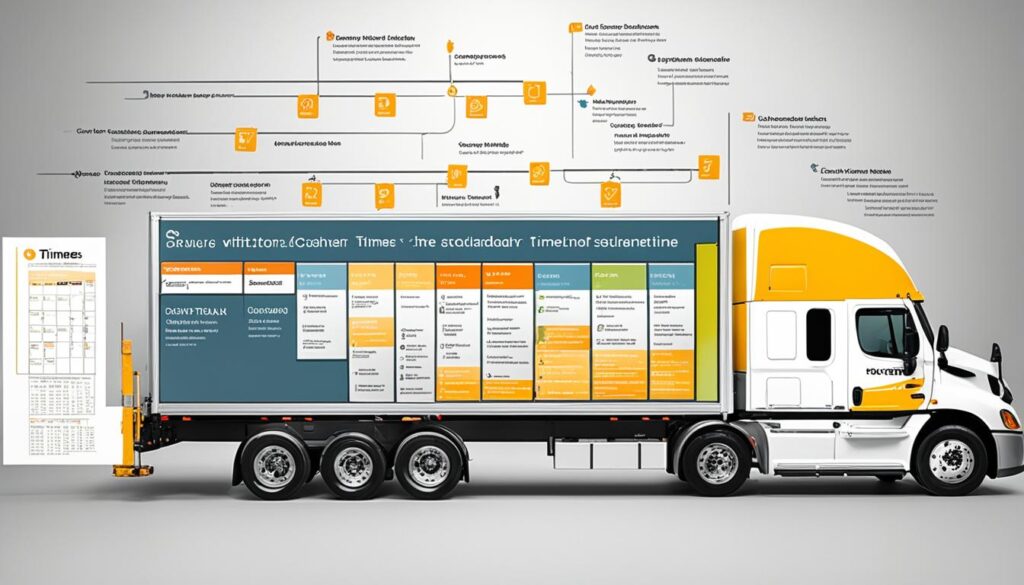
Preparing the Space for Installation
Before the actual installation of your new kitchen can begin, it is essential to prepare the space appropriately. Proper preparation ensures a smooth and efficient installation process, minimizing any potential delays or disruptions. In this section, we will discuss the steps involved in preparing the space for kitchen installation and how it can affect the overall timeline.
Here are some key steps to consider:
- Clearing the area: Start by removing any existing furniture, appliances, and debris from the kitchen. This includes cabinets, countertops, sinks, and old flooring. Clearing the area provides a clean slate for the installation process.
- Inspecting the walls and floor: Take the time to inspect the walls and floor for any damages or necessary repairs. Patch up any holes, cracks, or uneven surfaces to ensure proper installation of new cabinets and flooring.
- Measuring and marking: Accurate measurements are crucial for a successful kitchen fitment. Measure and mark the spaces where cabinets, appliances, and fixtures will be installed. This step allows for precise placement and alignment during the installation process.
- Levelling: It is essential to ensure that all surfaces are level before installing cabinets and countertops. Use a leveling tool to make any necessary adjustments and ensure a consistent and professional-looking installation.
- Electrical and plumbing considerations: If your kitchen design involves relocating electrical outlets or plumbing fixtures, it is crucial to coordinate these changes with a qualified electrician or plumber. Ensure all necessary connections and modifications are made before proceeding with the installation.
By properly preparing the space for kitchen installation, you can streamline the process and avoid any unnecessary delays. This stage sets the foundation for a successful renovation project, ensuring that the final result meets your expectations and adheres to the planned schedule.
Demolition and Removal of Existing Kitchen
In the process of fitting a new kitchen, one of the first steps is the demolition and removal of the existing kitchen. This phase involves dismantling the old cabinets, appliances, countertops, and other fixtures to make way for the new installation. It is a crucial part of the overall kitchen fitting timeline.
Demolition and removal can vary in duration depending on the size and complexity of your existing kitchen. A small kitchen with minimal fixtures may take less time, while a larger kitchen with extensive cabinetry and appliances may require more time for complete removal.
During this phase, it is essential to ensure proper disposal of the old kitchen components, adhering to local waste management regulations. Hiring professionals experienced in demolition and removal can contribute to a smoother and more efficient process.
“Properly demolishing and removing the existing kitchen is crucial to create a clean canvas for the new installation.”
While the time required for demolition and removal can vary, it is typically recommended to allocate a few days or up to a week for this phase. However, it is advisable to consult with your kitchen fitting professionals for a more accurate estimate based on your specific requirements.
Now that we have covered the demolition and removal phase, let’s move on to the next stage – the installation of cabinets, appliances, and fixtures.
Average Duration for Demolition and Removal
| Kitchen Size | Average Duration |
|---|---|
| Small Kitchen | 2-3 days |
| Medium Kitchen | 3-5 days |
| Large Kitchen | 5-7 days |
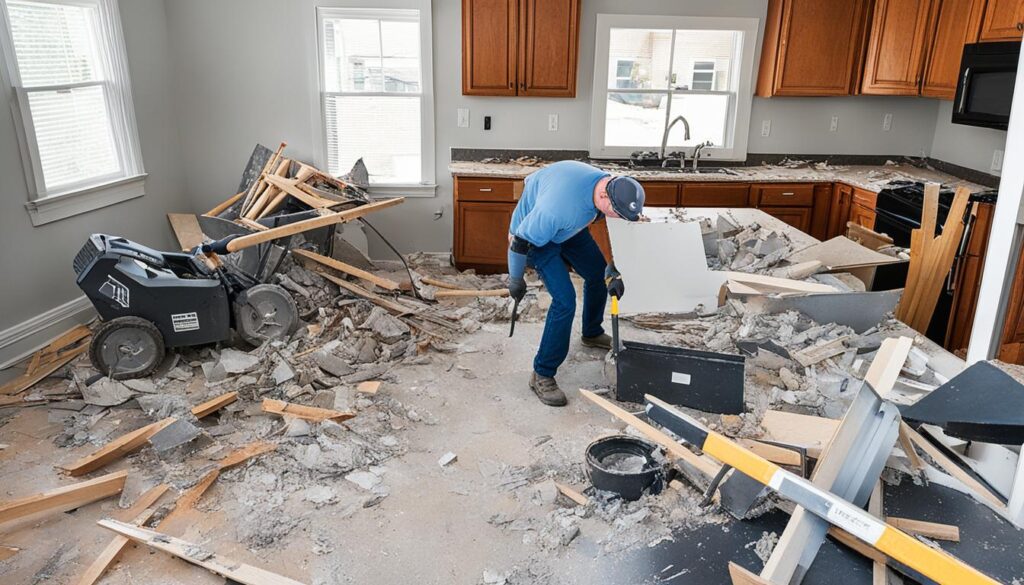
Disclaimer: The durations provided in the table above are approximate and can vary based on various factors such as kitchen complexity, scope of work, and contractor availability. It is recommended to consult with qualified professionals to get a more accurate estimate for your specific project.
Installation of Cabinets, Appliances, and Fixtures
Once the planning and preparation stages are complete, it’s time for the exciting part – the installation of cabinets, appliances, and fixtures. This step plays a crucial role in transforming your kitchen from a construction site into a functional and beautiful space for cooking and entertaining.
The duration of the installation process can vary depending on the complexity of your kitchen design, the size of the space, and the number of cabinets, appliances, and fixtures being installed. A typical kitchen fitting can take anywhere from a few days to several weeks to complete.
During the installation, skilled professionals will carefully position and secure your cabinets, ensuring they are level and properly aligned. They will also connect and test your appliances, such as the stove, refrigerator, and dishwasher, to ensure they are in working order.
When it comes to fixtures, plumbers will install and connect the sink, faucet, and garbage disposal, while electricians will handle the installation of lighting fixtures and outlets.
In some cases, additional adjustments or modifications may be required during the installation process to ensure everything fits perfectly and functions as intended. This attention to detail is important to create a seamless and functional kitchen space.
“The installation of cabinets, appliances, and fixtures is where your dream kitchen starts to take shape. It’s an exciting phase that brings functionality and beauty into your home.”
When it comes to the duration of this phase, it’s important to consider the intricacies involved in fitting each component. Custom cabinets or unique design elements may require additional time to install properly. Complex appliance setups, such as built-in refrigerators or ovens, may also increase the installation duration.
Here is a breakdown of the average time required for the installation of cabinets, appliances, and fixtures:
| Cabinet Installation | 1-3 days |
|---|---|
| Appliance Installation | 1-2 days |
| Fixture Installation (Plumbing and Electrical) | 1-2 days |
Keep in mind that these timeframes are estimates and can vary based on factors specific to your project. To ensure an accurate timeline for the installation of cabinets, appliances, and fixtures, consult with your kitchen fitment professional.
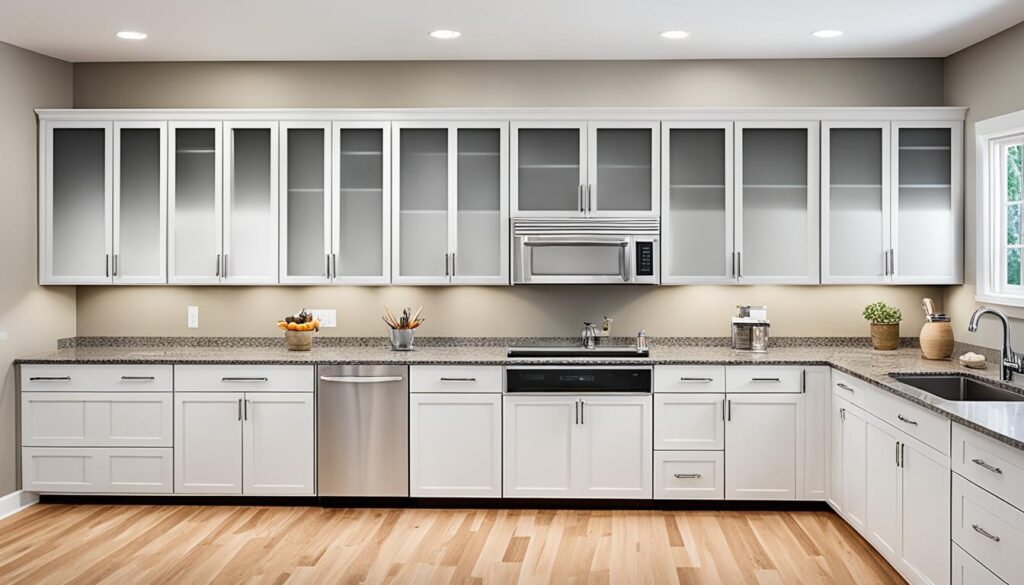
Takeaway:
The installation of cabinets, appliances, and fixtures is a critical step in fitting a kitchen. The duration of this process can vary depending on the complexity of your kitchen design and the number of components being installed. It’s important to work with experienced professionals who can ensure everything is properly installed and functional. Stay organized and communicate regularly with your fitment team to ensure a smooth and efficient installation process.
Plumbing and Electrical Work
Plumbing and electrical work play a vital role in the installation of a kitchen. These tasks ensure that your kitchen functions seamlessly and safely. Let’s explore the time required for these essential components and gain a better understanding of their impact on the overall duration of your kitchen installation.
When it comes to plumbing, the installation of sinks and faucets, as well as connecting water supply lines and drainage systems, are key elements that need careful attention. Depending on the complexity of your kitchen design and the number of plumbing fixtures involved, the time required for these tasks may vary. It’s crucial to hire professional plumbers who can efficiently install and connect all necessary components.
Similarly, electrical work involves installing lighting fixtures, electrical outlets, and ensuring proper wiring throughout your kitchen. These tasks require precise planning and execution to comply with safety regulations and create a functional electrical system. The time needed for electrical work can vary based on the complexity of your kitchen design and the number of electrical components involved.
Both plumbing and electrical work should be performed by licensed professionals to ensure compliance with building codes and safety standards. Hiring skilled contractors will not only save you time and effort but also give you peace of mind knowing that your kitchen installation is in capable hands.
Quotes:
“Proper plumbing and electrical work are crucial for a safe and functional kitchen installation. Hiring licensed professionals ensures that these tasks are completed efficiently and in compliance with regulations.” – Michelle Rodriguez, Kitchen Installation Expert
Typical Timeframes for Plumbing and Electrical Work
| Task | Timeframe |
|---|---|
| Installation of sinks and faucets | 2-4 hours |
| Connecting water supply lines and drainage systems | 4-6 hours |
| Installation of lighting fixtures | 2-4 hours |
| Installation of electrical outlets and wiring | 4-6 hours |
Keep in mind that these timeframes are estimates and can vary depending on the size of your kitchen, the complexity of the design, and the specific requirements of your project. It’s always recommended to consult with your contractor to get an accurate timeline for the plumbing and electrical work involved in your kitchen installation.
Next, we will explore the crucial steps involved in the final touches of your kitchen installation, including flooring and wall finishing.
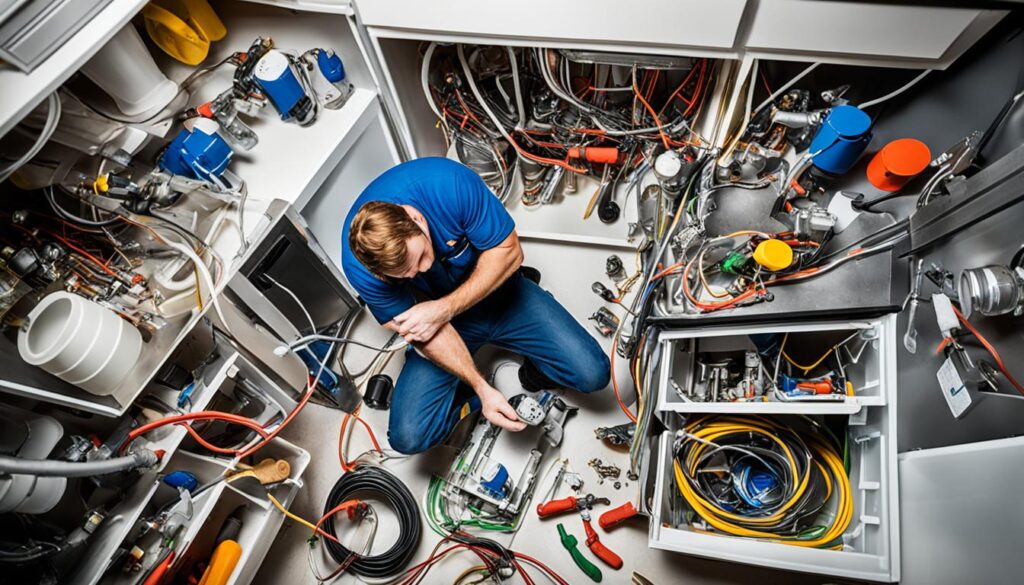
Flooring and Wall Finishing
The final touches in your kitchen installation are the flooring and wall finishing. These elements not only enhance the visual appeal of your kitchen but also contribute to its overall functionality. It’s essential to choose the right materials and finishes that can withstand the demands of a busy kitchen while complementing your design aesthetic.
The time required for flooring and wall finishing can vary depending on the complexity of your chosen materials, the size of your kitchen, and the extent of any necessary preparation work. The proper installation of flooring and wall finishes ensures their longevity and durability in the kitchen environment.
When it comes to choosing the flooring for your kitchen, options such as tiles, hardwood, laminate, or vinyl are popular choices. Each material has its advantages and considerations, such as durability, ease of maintenance, and resistance to moisture. Proper installation is crucial to ensure a level surface and prevent any issues in the future.
Tip: Consult with a professional contractor or designer to determine the best flooring material for your kitchen, considering factors such as your budget, style preferences, and practicality.
Wall finishing options like paint, wallpaper, or tile backsplashes can dramatically transform the look of your kitchen. The choice of wall finishes depends on your design style, maintenance preferences, and desired level of protection against water and grease splashes. Each material has unique installation requirements, such as priming, sanding, or grouting, to achieve a flawless and long-lasting finish.
Table: Comparison of Kitchen Flooring Materials
| Material | Pros | Cons |
|---|---|---|
| Tiles | Durable, easy to clean, wide range of styles | Can be cold underfoot, grout maintenance |
| Hardwood | Warm and inviting, adds value to the property | Not moisture-resistant, can be prone to scratches |
| Laminate | Affordable, easy to install, resistant to stains | Not suitable for wet areas, prone to damage from excess moisture |
| Vinyl | Waterproof, easy to clean, comfortable underfoot | Can fade or scratch over time, limited design options |
Table: Comparison of Kitchen Wall Finishes
| Finish | Pros | Cons |
|---|---|---|
| Paint | Wide color options, easy to change, cost-effective | Can be prone to chipping, requires regular maintenance |
| Wallpaper | Various patterns and textures, hides imperfections | Difficult to remove, not ideal for high-moisture areas |
| Tile | Durable, water-resistant, easy to clean | Installation can be time-consuming and costly |
The flooring and wall finishing phase is often one of the final steps in your kitchen installation. The timeline for completion will depend on the scope of work, such as the area to be covered and the intricacy of the installation. Hiring experienced professionals can help ensure the proper installation of these crucial components, keeping your project on schedule and delivering the desired results.
By carefully considering the time required for flooring and wall finishing and planning accordingly, you can ensure a smooth and efficient kitchen installation process. These finishing touches will bring your kitchen design together, creating a beautiful and functional space for you and your family to enjoy.
Quality Control and Final Inspections
To ensure that your kitchen is installed properly and meets the highest standards, quality control checks and final inspections are essential. These steps provide the necessary reassurance that your kitchen fitment is complete and ready for use. Let’s take a closer look at the important processes involved:
Quality Control Checks
- Verification of Measurements: Prior to final installation, a thorough review will be conducted to ensure that all dimensions and measurements are accurate. This step helps prevent errors and ensures a proper fit for cabinets, appliances, and fixtures.
- Checking for Proper Alignment: Quality control checks will be carried out to confirm that all components are aligned correctly, ensuring a seamless and visually appealing kitchen installation.
- Testing of Appliances and Fixtures: All appliances and fixtures will undergo rigorous testing to verify that they are in proper working order. This includes checking electrical connections, water flow, and any additional functionality specific to your kitchen design.
By conducting these quality control checks, any potential issues or discrepancies can be identified and resolved promptly, ensuring that your kitchen is flawless in both form and function.
Final Inspections
Once the quality control checks have been completed, a final inspection will be conducted to verify that everything is in order and meets the required standards. There are several key areas that will be assessed during this process:
- Appearance: The overall appearance of your kitchen will be evaluated to ensure that it aligns with your design vision and that all elements, such as cabinetry, countertops, and backsplash, are aesthetically pleasing.
- Functionality: Final inspections will assess the functionality of your kitchen, ensuring that all appliances, fixtures, and utilities are functioning properly and providing the expected performance.
- Safety and Compliance: It is essential to ensure that your kitchen installation meets all safety regulations and building codes. The final inspection will check for compliance in areas such as electrical wiring, plumbing connections, and ventilation.
Once the final inspection is successfully completed, your kitchen fitment can be considered complete, and you can confidently begin enjoying your newly installed kitchen.
| Quality Control Checks | Final Inspections |
|---|---|
| Verification of Measurements | Appearance |
| Checking for Proper Alignment | Functionality |
| Testing of Appliances and Fixtures | Safety and Compliance |
Conclusion
In conclusion, understanding the timeline for fitting a kitchen is crucial for proper planning and managing your renovation project. By considering the factors that affect the duration, you can ensure a smooth and efficient kitchen installation process.
From the planning and design phase to the final inspections, every step in fitting a kitchen plays a role in determining the overall timeline. Factors such as material procurement, space preparation, and the complexity of your kitchen design can all impact the duration of the installation.
It’s important to have a clear understanding of your project’s scope and timelines at the outset. By working closely with experienced kitchen installation professionals, you can effectively manage your renovation schedule and ensure that the process stays on track.





